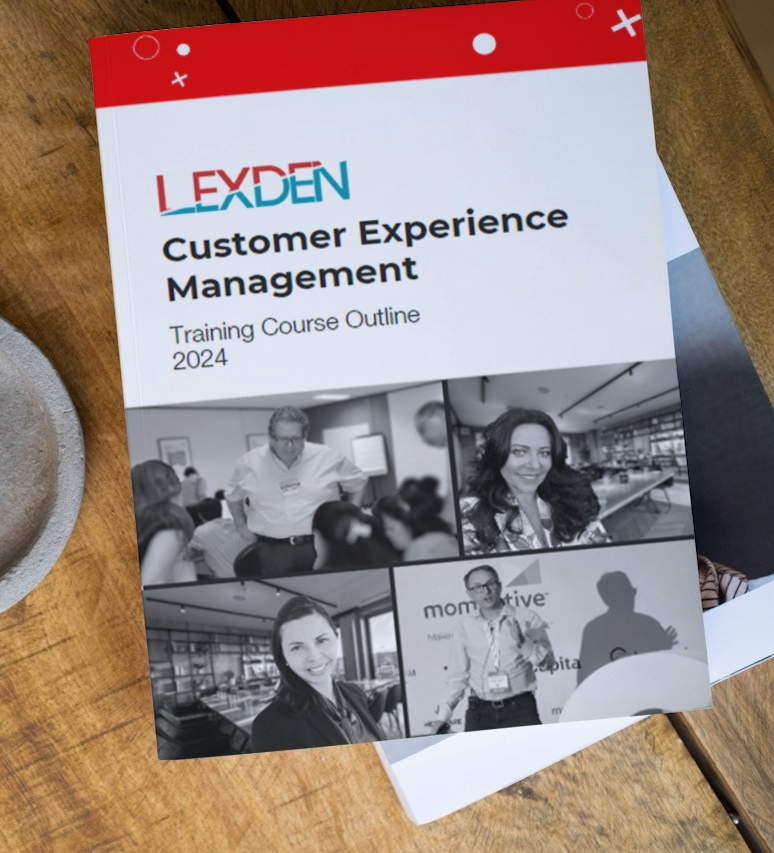Lexden’s Customer Experience Management Training focuses on three strategic pillars for success.; CX Motivation, Method, and Mindset.
CX Motivation – aligning customer centricity to business ambitions
For customer centricity to become a lasting driver of business success, it needs to be deeply ingrained within the organisation’s goals and aspirations. As an organisation navigates the ever-changing business landscape, customer centricity, as a practice, must consistently contribute to achieving those goals and be held accountable for its results.
During periods of prosperity, many departments within a company enjoy less scrutiny. However, when economic conditions worsen, those departments struggling to demonstrate their value become vulnerable to cuts. Unless customer centricity is positioned as a core practice, demonstrably aligned with business goals and a key enabler of the overall strategy, it’s just as susceptible to being sidelined as other departments like marketing, innovation, or even staffing levels.
Therefore, securing lasting customer centricity hinges on ensuring its value, relevance, and contribution are understood by senior leadership, cascading down through the organisation. We call this the CX ‘Motivation’ – the driving force behind a business’s commitment to customer-centricity.
There are various reasons why this can be problematic for customer-centric teams, all of which are covered in the first part of the Lexden CXM Training programme. Below we highlight three pain points associated with CX Motivation, which are commonplace.
The challenges of a CX leader
1. Leadership buy-in
“Certainty. Reliability. Evidence”
These are three words which fill a leadership team with confidence. However, customer-centric managers (or customer experience managers as often cited – but we will come on to that later), often provide subjectivity, emotion, and sentiment. These could not be further from the leadership need to hear. Why do CX leads get this so wrong? Largely because they are using performance data from customer satisfaction or Net Promoter Score surveys.
The insights provided against these measures are ‘intentions’, and do not correlate with customer behaviour. Whilst I state that I will recommend your business to someone else, the reality of me doing this is less than 20%, and the likelihood that that person I recommended you acting upon my instruction even less. In fact, a study by Prof Dr Phil Klaus showed that NPS and CSAT account for 1% of customer’s share of wallet decision making. This will create fear in even the most optimistic financial director.
It is this type of approach which breeds boardroom scepticism and fuels the alarming statistic: 90% of CX programs fail before takeoff.
2. Recognising what CX can contribute, and what it can’t
Who doesn’t exaggerate their worth in business? Well, CX has certainly confused leadership with its overclaim. CX has also managed to alienate itself from parts of the business by claiming spoils which at best should be shared with other parts of the business.
This goes back to the first point as well, ensuring that the expectations of the leadership team are managed in terms of the contribution CX can deliver.
Customer centricity is a foundational business practice. Effective customer experiences ensure intended outcomes are delivered seamlessly. However, attributing performance improvements solely to experience changes is inaccurate.
Take this B2B example:
B2B Scenario – who takes the credit?
Imagine a scenario where field sales reps, frustrated by order issues, were spending a staggering 50% of their time apologising to customers. This constant firefighting left little room for discussing new sales opportunities, impacting the company’s bottom line.
Enter the customer experience team. Recognising the urgency, they dove into the problem. They weren’t satisfied with just hearing apologies; they wanted to understand the root cause. By meticulously analysing customer service feedback, they unearthed a hidden culprit: inefficient processes creating bottlenecks in the order fulfillment chain. These bottlenecks were causing the very issues plaguing both customers and sales reps.
The CX team didn’t work in a silo. Armed with customer insights, they became the bridge, connecting with IT and Operations to form a cross-functional dream team. Together, they brainstormed solutions, leveraging customer suggestions gleaned from the feedback analysis. The result? A streamlined process that eliminated the order fulfillment roadblocks.
The impact was immediate. Sales reps, no longer bogged down by constant apologies, could finally focus on what they do best: closing deals. Customer satisfaction soared, and the company celebrated a 10% hike in sales.
Now, here’s the million-dollar question: who deserves the credit for this success story?
The sales team undoubtedly closed the deals. The product team provided the winning products. IT and Operations executed the critical process improvements. But what about CX?
CX played the role of the conductor, orchestrating the entire symphony. They identified the issue, fostered collaboration, and ensured the customer voice was heard throughout the process. Their contribution, while not a solo act, was a vital piece of the puzzle.
This scenario beautifully illustrates the collaborative nature of customer experience. It’s not about claiming sole credit, but about being the catalyst for positive change that drives customer-centricity and contributes to the company’s overall success.
It’s a collective effort, so be careful what you claim CX can do.
3. Strategic alignment to the business goals
Just like pricing, marketing, innovation, and supply chain, customer experience plays a critical role in achieving business goals. It supports the company’s strategy by helping it reach the defined targets through a customer-centric approach.
Therefore, it’s imperative that the customer experience management within the organisation has clear sight of these goals, and has identified how to support achieving them. Without this, CX is rudderless. According to studies completed by Stanford’s 2nd ranked scientist, over 90% of CX programmes fail. And one key reason is they are not aligned to the business, or other stakeholders objective.
Equip Yourself for Success: Lexden’s CX Management Training

Ready to bridge the gap between CX motivation and business results? Lexden’s comprehensive CX Management Training Programme equips you with the tools and frameworks needed to:
- Translate CX data into actionable insights that resonate with leadership.
- Develop a winning CX strategy aligned with your business goals.
- Foster a customer-centric culture across the organisation.
Don’t just manage customer experience, champion it!
Bonus Resource: The A-Z of the Modern Lexicon of CX
Feeling overwhelmed by the ever-evolving world of CX terminology? Download our free guide, “The A-Z of the Modern Lexicon of CX,” to gain a clear understanding of key CX concepts and terms used today.


